Astronomy is one of those subjects that lends itself to publication of a plethora of books.
Over the years my library has grown with a number of them. Apart from a few exceptions, they are either Star Atlases or observing guides.
I’ve also added a new section covering observing and imaging magazines. Most have now fallen by the wayside but archived copies are still available on the Web as PDF copies.
While the Star Atlas has almost been made redundant with the digital Planetarium on the computer or tablet, there is nothing quite like the smell and feel of the a huge two volume Uranometra to browse over on a cold ( and cloudy) winter night, dreaming of objects yet to observe.
The majority of the collection are made up of observing guides which in turn are almost exclusively written by Stephen James O’Meara. This guy who does his observing on the slopes of Mauna Kea in Hawaii under stupidly clear skies with a 100mm refractor, has a writing style that is highly infectious. While us mere mortals have to match his 100mm aperture with something getting on for 200mm or larger just to compete with his dark sky environment, I always get a kick when I compare my own observations with his. If I’m lucky, the two match quote closely, but that doesn’t happen often though.
Anyway, here is a list of books that I’ve found really useful and can highly recommend to any visual observer of the night sky
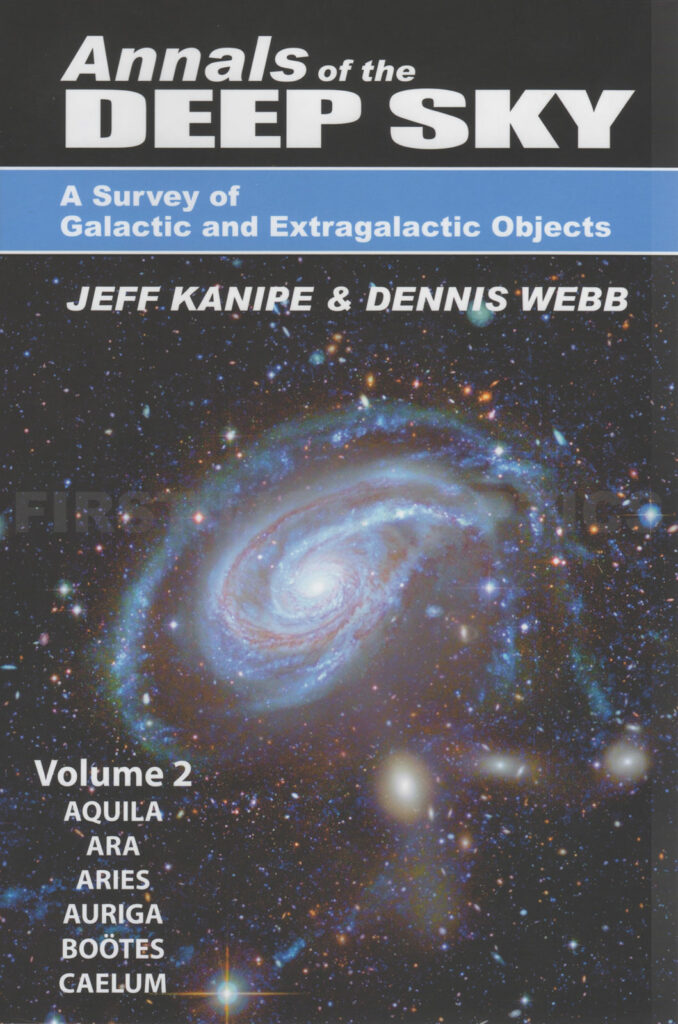
Annals of the Deep Sky
Annals of the Deep Sky is a comprehensive reference that guides amateur and semipro astronomers into every mind-boggling corner of the observational universe. Each volume presents extensive descriptions of prominent stars and deep-sky objects. No other popular work in astronomy provides the comprehensive historical background and astrophysical appraisals of prominent stars and celestial objects.
Volume 1: Covers Andromeda, Antlia, Apus, and Aquarius plus Introductions to Basic Astronomy and Astrophysics. – Volume 2: Covers Aquila, Ara, Aries, Auriga, Boötes, Caelum plus a 72-page Essential Terminology Glossary – Volume 3: Covers Camelopardalis, Cancer, Canes Venatici, Canis Major plus Worlds of Discovery: The Search for Exoplanets.- Volume 4: Covers Canis Minor, Capricornus, Carina, and Cassiopeia – Volume 5: Covers Centaurus, Cepheus and Cetus – Volume 6: Covers Chamaeleon, Circinus, Columba, Coma Berenices and Corona Australis – Volume 7: Covers Corona Borealis, Corvus, Crater and Crux – Volume 8: Covers Cygnus, Delphinus and Dorado – Volume 9: This volume is dedicated to the Milky Way’s nearest and largest satellite galaxies, the Magellanic Clouds.

Solar Astronomy: Observing, imaging and studying the Sun
Observing the Sun: there are many ways to enjoy solar observation, from visual observation to high resolution imaging, using commercial telescopes or home-made dedicated solar telescopes, from observation of the photosphere in “white light” to observation of the chromosphere with specialized narrow-band filters, including radio observation with a TV satellite dish.
The goal of this book is to provide a comprehensive guide to solar observation techniques, including examples and advice, for the beginner as well as the seasoned amateur. This book could not be the work of only one. The diversity of contributors is a testimony of the various possible fields in solar observation. Each contributor, with his own style and favourite topics, shares here with us his experience and passion.
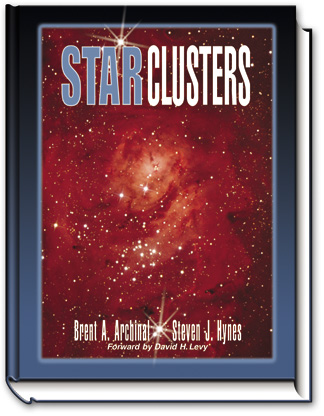
Star Clusters by Brent Archinal and Steven Hynes
Star Clusters covers, in just under 500 pages, star clusters, globular clusters, asterisms and other objects that have been misidentified as such.
It is both a descriptive text of the historical study and astrophysics of some the youngest (open clusters) and oldest (globular clusters) objects that populate the Universe along with the most up-to-date catalogue of these objects in existence—an effort that has taken more than a decade to complete. Over the last few hundred years many of these objects have been repeatedly rediscovered and subsequently renamed, misidentified as to their true nature, or given incorrect celestial coordinates.
Altogether there are 5,045 individual objects catalogued in this work that have a total of 13,949 “alias” names on average, nearly 3 names for each object. This work catalogues 2,017 clusters in the Milky Way or previously misidentified as Milky Way clusters, including 151 globular clusters or possible globular clusters, and 1547 open clusters or possible open clusters. Also catalogued are clusters or objects misidentified as such in several of the Local Group galaxies. This includes 2,025 objects in the Large Magellanic Cloud, 419 objects in the Small Magellanic Cloud, 578 objects in the Andromeda (M 31) galaxy and 6 objects in the Fornax Dwarf galaxy.
An extensive Appendix explains the origin of all object names and abbreviations and provides detailed references to the original source material for all object discoveries.
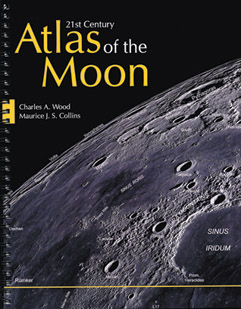
Atlas of the Moon
Lunar scientist and Sky & Telescope columnist Charles A. Wood teamed up with amateur astronomer Maurice J. S. Collins to produce The 21st Century Atlas of the Moon.
This spiral-bound atlas is based on global maps derived from Lunar Reconnaissance Orbiter images. It divides the lunar nearside into 28 sections, plus it has an additional 8 charts that depict the limb regions visible from Earth during favorable librations. Each full-page chart is accompanied by notes explaining which Lunar 100 targets are visible.
The book also provides close-up highlights of major features with pertinent geological and historical information. Four full Moon maps are also included, as are sections on lunar basins, mare ridges, and the landing sites of the Apollo missions and robotic probes.
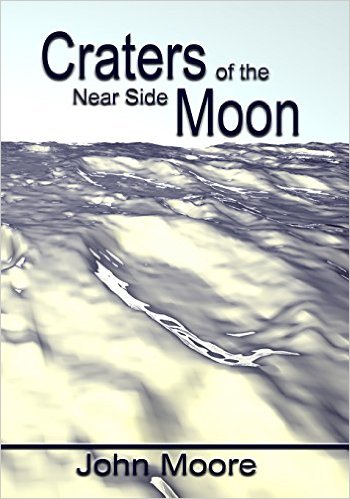
Craters of the Near Side Moon
In Craters of the Near Side Moon you will find 662 referenced craters in highly-resolved images taken by cameras onboard the Lunar Reconnaissance Orbiter.
All craters are shown from an earth-based perspective, accompanied by an additional aerial, topographical view showing their positions, and any other sub-craters (over 5000 listed) related to them. All 662 are discussed from a geological perspective and the features to look for, along with suggested times in when best to view them. Most importantly, every crater, and sub-crater, has the latest official size, latitude and longitude coordinates as laid down by the International Astronomical Union (IAU).
Three-quarters of the 662 craters discussed also include a second high-rez aerial representation from a different perspective view in both lighting and detail; giving the observer that extra bit of information required. The craters are listed alphabetically for ease of finding, while a list of other features, such as, rilles to ridges to maria and mountains…etc., is given at the book’s end (again, with official IAU designations).
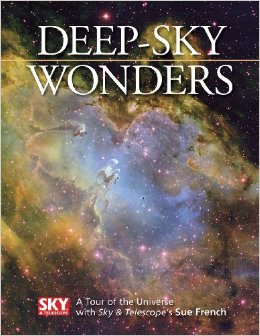
Deep Sky Wonders
A new collection from Sky and Telescope’s popular columnist.
Sue French’s elegant, informative monthly columns in Sky and Telescope magazine have won this astronomy writer a passionate following among astronomy enthusiasts. In 2005, French published 60 of these columns in Celestial Sampler, a book that garnered rave reviews and earned bestseller sales.
Deep-Sky Wonders also features a variety of challenging objects that encourage observers to test the limits of their equipment and skills. Fragments of poetry and prose enliven the text, while each tour illuminates little-known seasonal wonders that lie off the beaten path. From a January journey down the celestial river Eridanus to an autumnal visit to the den of Vulpecula, the Little Fox, French brings the wonders of the sky to life.
Suitable for beginning and intermediate small-scope astronomers as well as large-scope viewers and astrophotographers, this book will be greeted enthusiastically by all Sky and Telescope readers, especially French’s many fans. It is also an outstanding introduction to deep-sky viewing for novice observers.
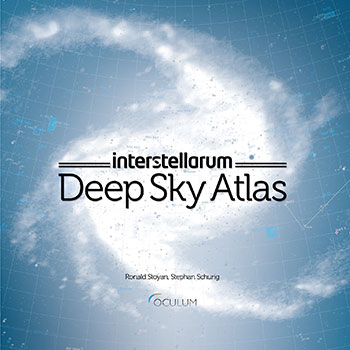
Interstellarum Deep Sky Atlas
The interstellarum Deep Sky Atlas heralds a new era of celestial cartography. It is an innovative, practical tool for you to choose and find stars, star clusters, nebulae, and galaxies. Thanks to its revolutionary new concept, it is aimed at users of all experience levels. There are two editions of interstellarum Deep Sky Atlas. The contents are identical.
Desk Edition: This edition is printed on heavy paper with a cardboard cover. It is spiral bound and can be flipped over. The legend is printed on the inner sleeve of the cover. This edition will last for a lifetime of observing if handled with minimum care.
Field Edition: This edition comes in a sturdy slipcase. The maps are printed on Polyart, which feels like paper, but is a sophisticated polyethylene foil. The cover is Priplak, a durable PVC material. The legend comes separately and can be put in a jacket on the inner sleeve. The entire set is waterproof and tear-resistant. You can write on it with water-soluble ink, and wipe it away. If getting wet, the atlas can be simply dried by wiping over the pages with a dry cloth. The pages will not get worn even if after being soaked into an aquarium!
Published by the editors of interstellarum, Germany’s leading magazine for practical astronomy!
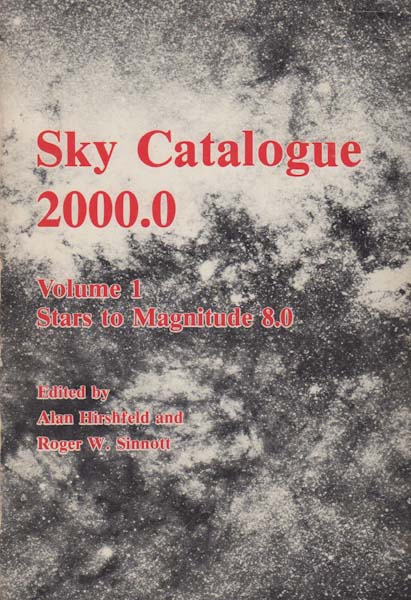
The Sky Catalogue 2000.0 Volume 1
This is a re-issue of a book first published in 1985 (see Abstr. 39.002.019). This is a standard reference work for telescope users which gives positional and other data for galaxies, double and variable stars, and star clusters. It includes tables on 20,000 objects. Comprehensive treatment is given for each object: position for epoch 2000.0, magnitudes in the UBV photometric system, color index, surface brightness and Hubble classification for galaxies. Contents: Glossary of selected astronomical names. Index to letter names of variable stars. Double and multiple stars. Visual binary stars. Spectroscopic binary stars. Variable stars. Suspected variable stars. Open clusters. Open cluster cross index. Globular clusters. Bright nebulae. Dark nebulae. Planetary nebulae. Galaxies. Quasi-stellar objects (QSO’s). Radio sources. X-ray sources.
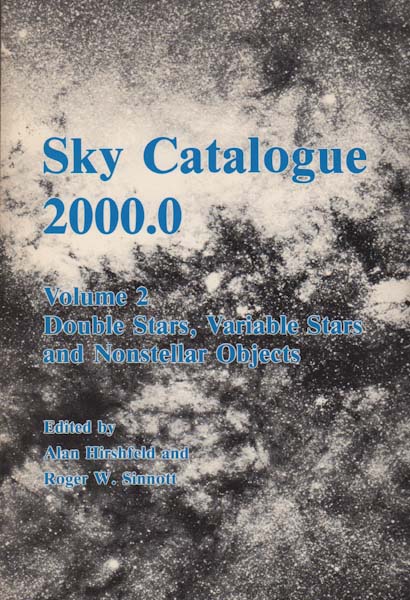
The Sky Catalogue 2000.0 Volume 2
This compendium summarises the astronomical data for all stars brighter than magnitude 8.0. For every object listed, it includes designations from the HD (Henry Draper) and SAO (Smithsonian Astrophysical Observatory) star catalogues; the star name and constellation; the common name; the position for the equinox and epoch 2000.0; the star’s proper motion; its visual magnitude and colour index; the absolute magnitude; the spectral type; the radial velocity; the infrared distance; and, where appropriate, additional information on multiplicity, variability and cluster membership.
There is an index of Flamsteed and Bayer designations as well. The information given in this catalogue is derived from the SIMBAD (Set of Identifications, Measurements and Bibliographical references of Astronomical Data) database held at the Strasbourg Observatory. This is the definitive reference set used in professional astronomy. Serious observers of stars and star systems will appreciate the new edition of this established reference work.

Observing and Cataloguing Nebulae and Star Clusters
The New General Catalogue, originally created in 1888, is the source for referencing bright nebulae and star clusters, both in professional and amateur astronomy. With 7840 entries, it is the most-used historical catalogue of observational astronomy, and NGC numbers are commonly used today. However, the fascinating history of the discovery, observation, description and cataloguing of nebulae and star clusters in the nineteenth century has largely gone untold, until now. This well-researched book is the first comprehensive historical study of the NGC, and is an important resource to all those with an interest in the history of modern astronomy and visual deep-sky observing. It covers the people, observatories, instruments and methods involved in nineteenth-century visual deep-sky observing, as well as prominent deep-sky objects. The book also compares the NGC to modern object data, demonstrating how important the NGC is in observational astronomy today.
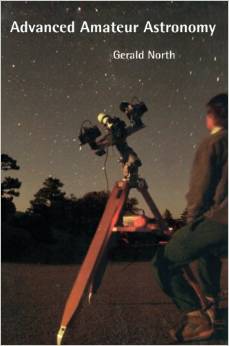
Advanced Amateur Astronomy
This book, first published in 1997, is for amateur astronomers and telescope users who want to move beyond elementary stargazing to more challenging projects. Written by an accomplished amateur astronomer, this indispensable guide to more advanced work is packed with information and lucid explanations. The first section of the book sets out the fundamental principles of practical astronomy, with chapters on telescope optics, the atmosphere, telescope hardware, astrophotography and electronic imaging. This knowledge is then applied to the full range of celestial bodies accessible by telescope: the solar system, stars and galaxies. For those users who want to move to even greater challenges, chapters on photometry, spectroscopy and radio astronomy bring observational astronomy to a level where data of real scientific value can be acquired.
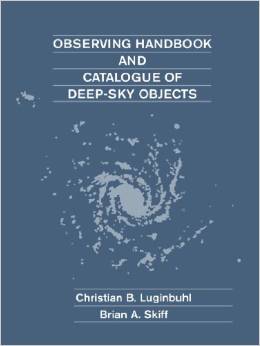
This book grew out of the lack of a comprehensive modern manual to aid in observing deep-sky objects.
All earlier guides are either outdated, lacking in descriptive detail, or limited in their scope. we began by undertaking a systematic program of visual observations. the aim being to observe each of approximately 1500 galaxies. star clusters. and nebulae through three telescopic apertures commonly used by amateur astronomers. As observing proceeded, we collected data on each object from a wide variety of sources, mostly reference catalogues and scientific papers in the professional literature. Accurate total magnitudes were newly derived for open clusters and planetary nebulae. Further. each object was examined after observation on at least one of three photographic sky atlases or on large- scale telescopic photographs to ensure the authenticity of details we recorded visually. Consequently. what we present is not merely a list of visual observations. but a compendium of information relevant to viewing the brightest deep-sky objects. Included are dimensions. magnitudes, orientations, and angular distances. verified in nearly all cases through photography. photometry, or astrometry. Of the 88 constellations in the sky, 68 north of Declination – 50′ are encompassed by the present survey.
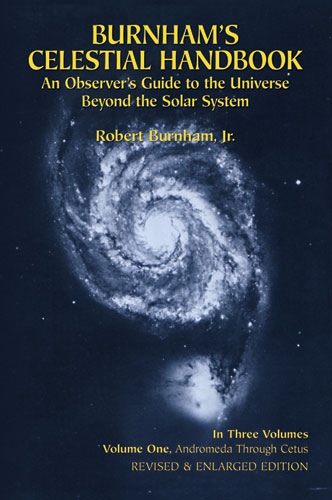
Burnham’s Celestial Handbook: Three Volume Series
While there are many books on stars, there is only one Celestial Handbook. Now completely revised through 1977, this unique and necessary reference is available once again to guide amateur and advanced astronomers in their knowledge and enjoyment of the stars.
After an extensive introduction in Volume I, which gives the beginner enough information to follow about 80% of the body of the material, the author gives comprehensive coverage to the thousands of celestial objects outside our solar system that are within the range of telescopes in the two- to twelve-inch range. The objects are grouped according to the constellations in which they appear. Each constellation is divided into four subject sections: list of double and multiple stars; list of variable stars; list of star clusters. nebulae and galaxies; and descriptive notes. For each object the author gives names, celestial coordinates, classification, and full physical description. These, together with a star atlas, will help you find and identify almost every object of interest.
But the joy of the book is the descriptive notes that follow. They cover history, unusual movements or appearances, and currently accepted explanations of such visible phenomena as white dwarfs, novae and supernovae, cepheids, mira type variables, dark
nebulae, gaseous nebulae, eclipsing binary stars, the large Magellanic cloud, the evolution of a star cluster, and hundreds of other topics, many of which are difficult to find in one place.
While a little out of date now, this three volume set is still a wonderful resource.
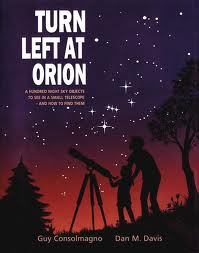
Turn Left at Orion
A guidebook for beginning amateur astronomers, Turn Left at Orion provides all the information you need to observe the Moon, the planets and a whole host of celestial objects. Large format diagrams show these objects exactly as they appear in a small telescope and for each object there is information on the current state of our astronomical knowledge. Revised and updated, this new edition contains a chapter describing spectacular deep sky objects visible from the southern hemisphere, and tips on observing the upcoming transits of Venus. It also includes a discussion of Dobsonian telescopes, with hints on using personal computers and the internet as aids for planning an observing session. Unlike many guides to the night sky, this book is specifically written for observers using small telescopes. Clear and easy-to-use, this fascinating book will appeal to skywatchers of all ages and backgrounds. No previous knowledge of astronomy is needed.
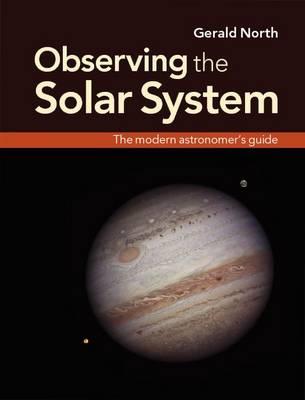
Observing the Solar System
Written by a well-known and experienced amateur astronomer, this is a practical primer for all aspiring observers of the planets and other Solar System objects. Whether you are a beginner or more advanced astronomer, you will find all you need in this book to help develop your knowledge and skills and move on to the next level of observing. This up-to-date, self-contained guide provides a detailed and wide-ranging background to Solar System astronomy, along with extensive practical advice and resources. Topics covered include: traditional visual observing techniques using telescopes and ancillary equipment; how to go about imaging astronomical bodies; how to conduct measurements and research of scientifically useful quality; the latest observing and imaging techniques. Whether your interests lie in observing aurorae, meteors, the Sun, the Moon, asteroids, comets, or any of the major planets, you will find all you need here to help you get started.
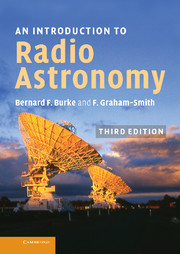
An Introduction to Radio Astronomy
Written by two prominent figures in radio astronomy, this well-established, graduate-level textbook is a thorough introduction to radio telescopes and techniques. It is an invaluable overview for students and researchers turning to radio astronomy for the first time. The first half of the book describes how radio telescopes work – from basic antennas and single aperture dishes through to full aperture-synthesis arrays. It includes reference material on the fundamentals of astrophysics and observing techniques. The second half of the book reviews radio observations of our galaxy, stars, pulsars, radio galaxies, quasars, and the cosmic microwave background. This third edition describes the applications of fundamental techniques to newly developing radio telescopes, including ATA, LOFAR, MWA, SKA, and ALMA, which all require an understanding of aspects specific to radio astronomy. Two entirely new chapters now cover cosmology, from the fundamental concepts to the most recent results of WMAP.

Full Moon
Full Moon is a photographic journey to the Moon and back, drawn from NASA’s 32,000 pictures from the Apollo missions. For the first time NASA has allowed 900 of the ‘master’ negatives and transparencies to be taken offsite for electronic scanning so as to produce the sharpest images of space that we have ever seen. From this selection of ‘master’ photographs Michael Light has distilled a single composite journey beginning with the launch, followed by a walk in space, an orbit of the Moon, a lunar landing and exploration and a return to Earth with an orbit and splash-down. Five enormous gatefold panoramas show the extraordinary lunar landscape. These photographs reveal not only the hardware of lunar exploration in exquisite detail but also the profound aesthetics of space in what could be described as the ultimate landscape photography. The reader is encouraged to view these pictures as more than a spectacle. You start to experience them with a sense of the accompanying disorientation and excitement that the astronauts themselves would have felt.
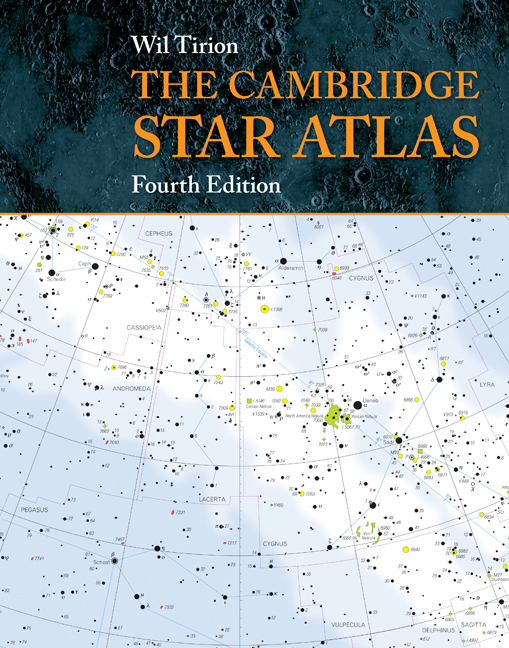
The Cambridge Star Atlas
This classic star atlas is ideal for both beginning astronomers and more experienced observers worldwide. The clear, full-color maps show stars, clusters and galaxies visible with binoculars or a small telescope. The atlas also features constellation boundaries and the Milky Way, and lists objects that are interesting to observe. This new edition features a clearer map of the Moon’s surface, showing craters and features; a second Moon map, mirror reversed for users of telescopes with star diagonals; enhanced index charts showing the constellations more clearly; and a new data table listing stars hosting planetary systems. It is now spiral bound, making it ideal for use at the telescope.

Herschel 400 Observing Guide
The Herschel 400 is a list of 400 galaxies, nebulae, and star clusters, picked from over 2,500 deep-sky objects discovered and catalogued by the great eighteenth-century astronomer Sir William Herschel and his sister Caroline. It comprises 231 galaxies, 107 open clusters, 33 globular clusters, 20 planetary nebulae, 2 halves of a single planetary nebula, and 7 bright nebulae. In this guide Steve O’Meara takes the observer through the list, season by season, month by month, night by night, object by object. He works through the objects in a carefully planned and methodical way, taking in some of the most dramatic non-Messier galaxies, nebulae, and star clusters in the night sky. Ideal for astronomers who have tackled the Messier objects, this richly illustrated guide will help the amateur astronomer hone their observing skills.

Hidden Treasures
Stephen O’Meara’s new and exciting observing guide spotlights an original selection of 109 deep-sky objects that will appeal to sky-watchers worldwide. His ‘hidden treasures’ include a wonderful assortment of galaxies, open clusters, planetary nebulae and more, all of which have been carefully chosen based on their popularity and ease of observing. None of these objects are included in either the Messier or the Caldwell catalogs, and all are visible in a 4-inch telescope under dark skies. Stunning photographs and beautiful drawings accompany detailed visual descriptions of the objects, which include their rich histories and astrophysical significance. The author’s original finder charts are designed to help observers get to their targets fast and efficiently.
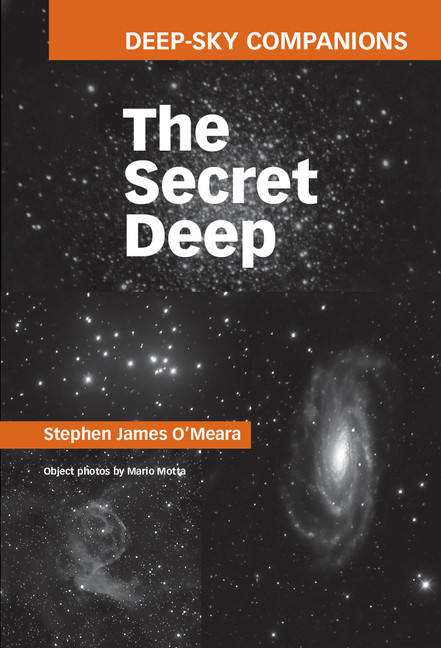
The Secret Deep
In this fresh list, Stephen James O’Meara presents 109 new objects for stargazers to observe. The Secret Deep list contains many exceptional objects, including a planetary nebula whose last thermal pulse produced a circumstellar shell similar to the one expected in the final days of our Sun’s life; a piece of the only supernova remnant known visible to the unaided eye; the flattest galaxy known; the largest edge-on galaxy in the heavens; the brightest quasar; and the companion star to one of the first black hole candidates ever discovered. Each object is accompanied by beautiful photographs and sketches, original finder charts, visual histories and up-to-date astrophysical information to enrich the observing experience. Featuring galaxies, clusters and nebulae not covered in other Deep-Sky Companions books, this is a wonderful addition to the series and an essential guide for any deep-sky.
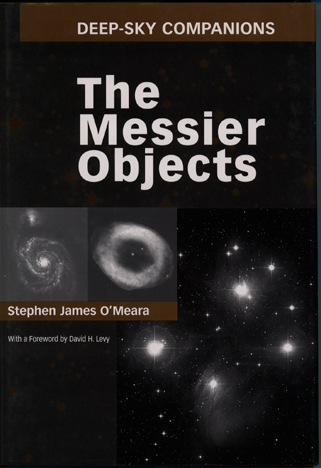
The Messier Objects
The 110 galaxies, star clusters and nebulae catalogued by the comet hunter Charles Messier in the late 1700s are still the most widely observed celestial wonders in the heavens. They are the favourite targets of amateur astronomers, with such rich variety and detail that they never cease to fascinate. This book provides new and experienced observers with a fresh perspective on the Messier objects. Stephen James O’Meara has prepared a visual feast for the observer. Using the finest optical telescopes available for amateur work, superior eyepieces and the darkest site on Earth, he describes and sketches the view from the telescope as never before. There are new drawings, improved finder charts, and new astronomical data on each object, including findings from the Hubble Space Telescope. This is truly the Messier Guide for the modern age.

Observing the Night Sky With Binoculars
Month by month, star by star, object by object, Stephen James O’Meara takes readers on a celestial journey to many of the most prominent stars and constellations visible from mid-northern latitudes. Filled with interesting anecdotes about the stars and constellations and their intriguing histories, this book is both a useful guide for amateur astronomers, and a great first-time reference for those just starting out. After describing a constellation’s mythology, readers are guided in locating and identifying its brightest stars in the sky, as well as any other bright targets of interest – colourful stars, double or multiple stars, star clusters and asterisms, nebulae, galaxies, variable stars, and more. This book will help beginning stargazers become familiar with the stars and constellations visible from their backyards, and explore the brightest and best stars, nebulae, and clusters visible through inexpensive, handheld binoculars.
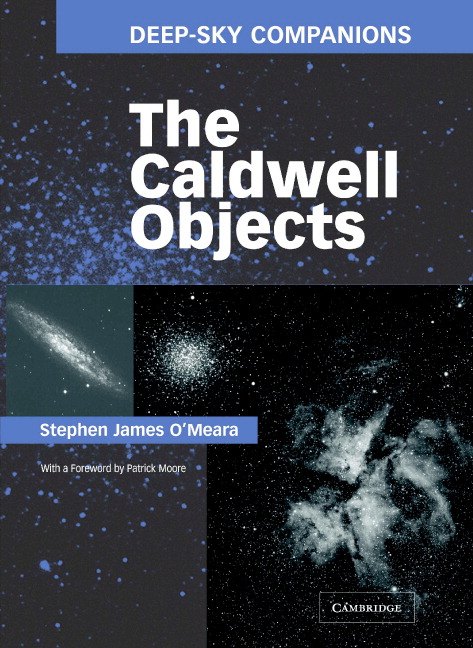
The Caldwell Objects
For more than two centuries, amateur astronomers have earned their stripes by observing the 109 star clusters, nebulae, and galaxies catalogued by French comet hunter Charles Messier. Now a new list of 109 equally appealing deep-sky delights is bringing a new generation of astronomers even closer to the beauty and mystery of the night sky. Carefully compiled by Sir Patrick Moore, the Caldwell Catalogue covers the entire celestial sphere, highlighting cosmic wonders for observers worldwide. Stephen James O’Meara has tirelessly observed all 109 Caldwell objects. Deep-Sky Companions: The Caldwell Objects presents not only his beautiful sketches and detailed visual descriptions – it discusses each object’s rich history and astrophysical significance. The latest fundamental data on each object are tabulated, and the book’s star charts will lead observers to each object’s precise location. This book is co-published with Sky Publishing Corporation.
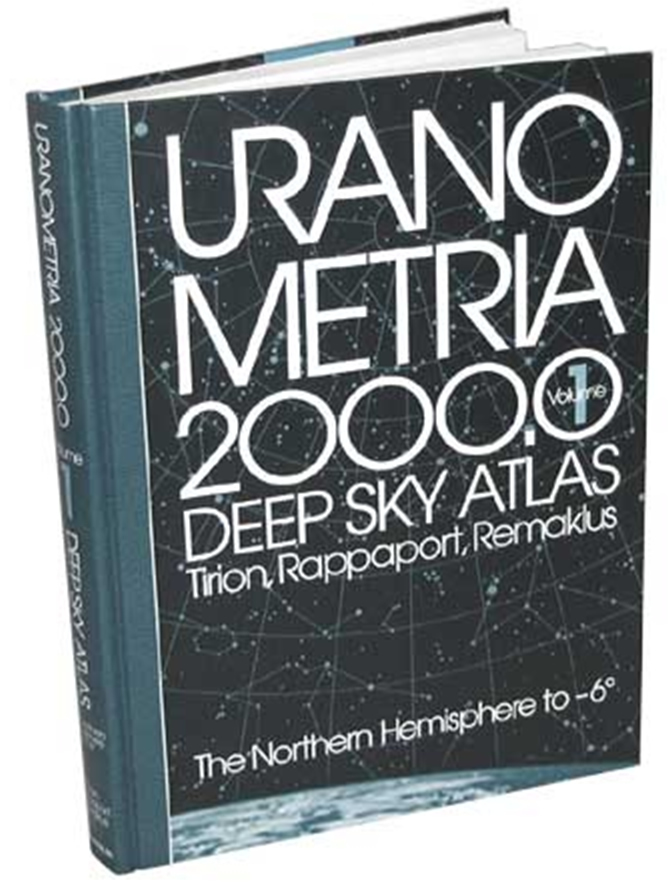
Uranometria 2000.0 Deep Sky Atlas; Volume One
Years in development, this massive achievement affords astronomers, astro photographers and CCD imagers the finest roadmap to the heavens yet produced at such a modest price. More than 280,000 stars and over 30,000 deep sky non-stellar objects are located with a degree of accuracy heretofore unavailable in one resource. Encyclopaedic in nature, with beautifully redrawn maps, a host of efficient navigation tools, and more accurate catalogue data for three times the number of deep sky objects shown in the preceding work, Uranometria 2000.0 is clearly an atlas and guide every telescope user, whatever their aperture, will want to own. The pages below will serve to introduce you to the top-tier features of this exciting new work, but can in no way demonstrate the incredible depth and richness of the data presented in Uranometria. Volume One Includes The Northern hemisphere to -6 degrees.

Uranometria 2000.0 Deep Sky Atlas; Volume Two
Years in development, this massive achievement affords astronomers, astro photographers and CCD imagers the finest roadmap to the heavens yet produced at such a modest price. More than 280,000 stars and over 30,000 deep sky non-stellar objects are located with a degree of accuracy heretofore unavailable in one resource. Encyclopaedic in nature, with beautifully redrawn maps, a host of efficient navigation tools, and more accurate catalogue data for three times the number of deep sky objects shown in the preceding work, Uranometria 2000.0 is clearly an atlas and guide every telescope user, whatever their aperture, will want to own. The pages below will serve to introduce you to the top-tier features of this exciting new work, but can in no way demonstrate the incredible depth and richness of the data presented in Uranometria. The Southern hemisphere to +6 degrees.
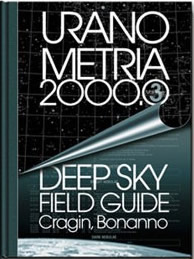
Uranometria 2000.0 : Deep Sky Field Guide
A companion to Uranometria 2000 is the Deep Sky Field Guide to Uranometria 2000. This highly useful guide provides tabular data for virtually all the deep-sky objects found on the charts. The data is tabulated by chart number, and organized by object class (open cluster, planetary nebula, galaxy, etc.). While not purely essential for observing, it provides a wealth of information on virtually anything you want to observe.
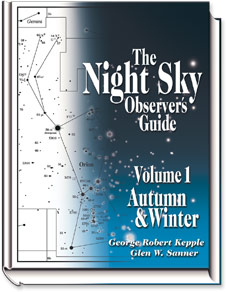
The Night Sky Observers Guide: Two Volume Set
A subtitle to the two-volume Night Sky Observer’s Guide could have been Burnham’s Celestial Handbook: The Next Generation… (it is) a bible of very deep-sky observing, taking objects constellation by constellation with full page charts and numerous smaller finder charts and drawings. Tables list variable and double stars, and a few individual stars are highlighted. But the meat of the volumes is the descriptions of galaxies, nebulae and star clusters as they appear through a variety of apertures. If you’re looking for targets to keep you busy and challenge your observing skills, the Night Sky Observer’s Guide has come to your rescue.

The Herschel Partnership
The partnership between William Herschel (1738–1822) and his sister Caroline (1750–1848) transformed astronomy from the study of the solar system, with the stars as little more than a backcloth, to the exploration of the stellar system, the nebulae, and the cosmos as a whole.
This book examines the partnership from the viewpoint of Caroline, and reveals the sacrifices she was called on to make and the effects these had on her.
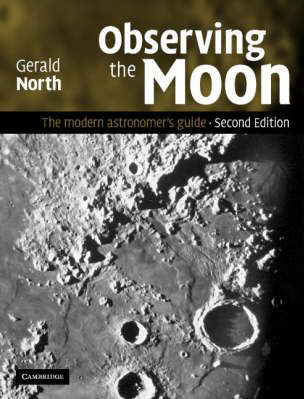
Observing the Moon
Written by an experienced and well-known lunar observer, this is a hands-on primer for the aspiring observer of the Moon. Whether you are a novice or are already experienced in practical astronomy, you will find plenty in this book to help you raise your game to the next level and beyond. In this thoroughly updated Second Edition, the author provides extensive practical advice and sophisticated background knowledge of the Moon and of lunar observation. It incorporates the latest developments in lunar imaging techniques, including digital photography, CCD imaging, and webcam observing, and essential advice on collimating all common types of telescope.
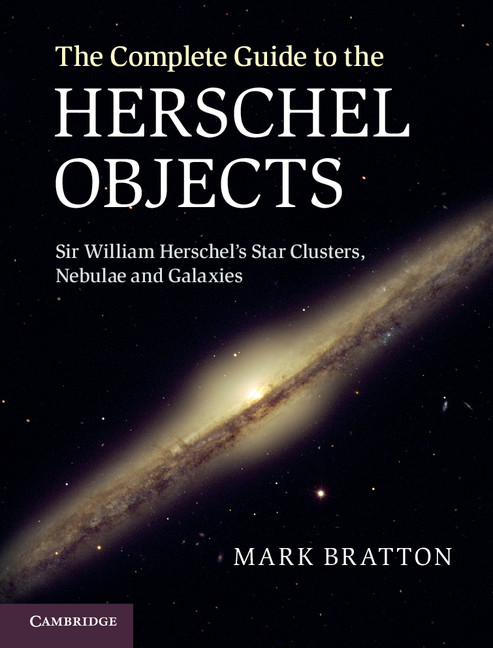
The Complete Guide to the Herschel Objects
Sir William Herschel’s contributions to astronomy during the late eighteenth century are unrivalled. His lasting legacy is his dedicated all-sky survey of star clusters and nebulae, and these objects continue to be among the most studied in the night sky. This unique book provides a complete re-examination of Herschel’s entire catalogue of non-stellar discoveries, making it the most accurate and up-to-date reference of its kind. Retrace the footsteps of one of history’s greatest astronomers and explore every one of Herschel’s landmark discoveries, including those considered to be lost or non-existent. Read detailed notes about each object’s appearance and physical characteristics, and view hundreds of photos of the most intriguing Herschel objects, along with dozens of sketches of what is visible at the eyepiece. This superb book is a must-have for amateur astronomers seeking new and exciting observing challenges, and as the ultimate reference on the Herschel objects.
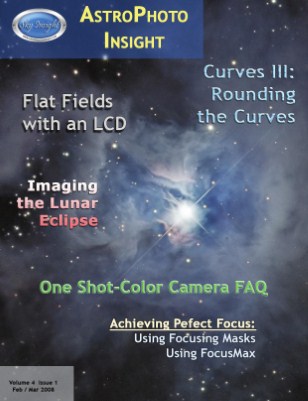
AstroPhoto Insight Magazine
AstroPhoto Insight, published by Professional Insight from 2005 to 2012, was a bi-monthly digital astrophotography magazine dedicated to exploring and sharing the latest innovations and techniques in the field of cutting-edge amateur astrophotography.
A typical issue will contained hardware reviews on imaging equipment such as CCD, DSLR, and telescopes; software reviews, tutorials (e.g. Photoshop techniques), user projects and modifications, and any number of reader submitted articles. Emphasis was always on the practical side of astrophotography; with plenty of information on equipment, software, and techniques to help the enthusiast get the most out of their astrophotography experience.
Astrophoto Insight, while offering enough material to keep even the most hard-core astrophotographer interested, still offered a variety of practical and “basic” information to be of great value to the beginner as well. Survey of readers confirmed its broad appeal across all levels of astrophotographers.
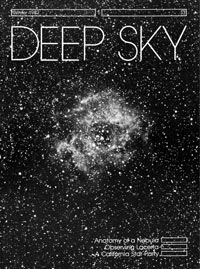
Deep Sky Magazine
There was a time, long ago, when the publishers of Astronomy brought you two smaller quarterly magazines as well: Deep Sky and Telescope Making. These sister publications were extremely popular with amateur astronomers in the boom days of the Dobsonian revolution, when large telescopes were first available to amateurs and an explosion of knowledge about what could be seen in the sky was first happening.
I started Deep Sky as a monthly publication when I was a sophomore in high school in Ohio. In 1982 I joined the Astronomy staff and brought my magazine with me. We published it as a quarterly for 10 years. For some years, copies of Deep Sky have been collectors’ items at star parties and swap meets, as the many articles written by dozens of amateur observers contain still-valuable information about countless clusters, nebulae, and galaxies.
Now, thanks to the hard work and coordination of Online Editor Matt Quandt and others, issues of Deep Sky magazines will be available again — this time electronically, as downloadable PDFs.
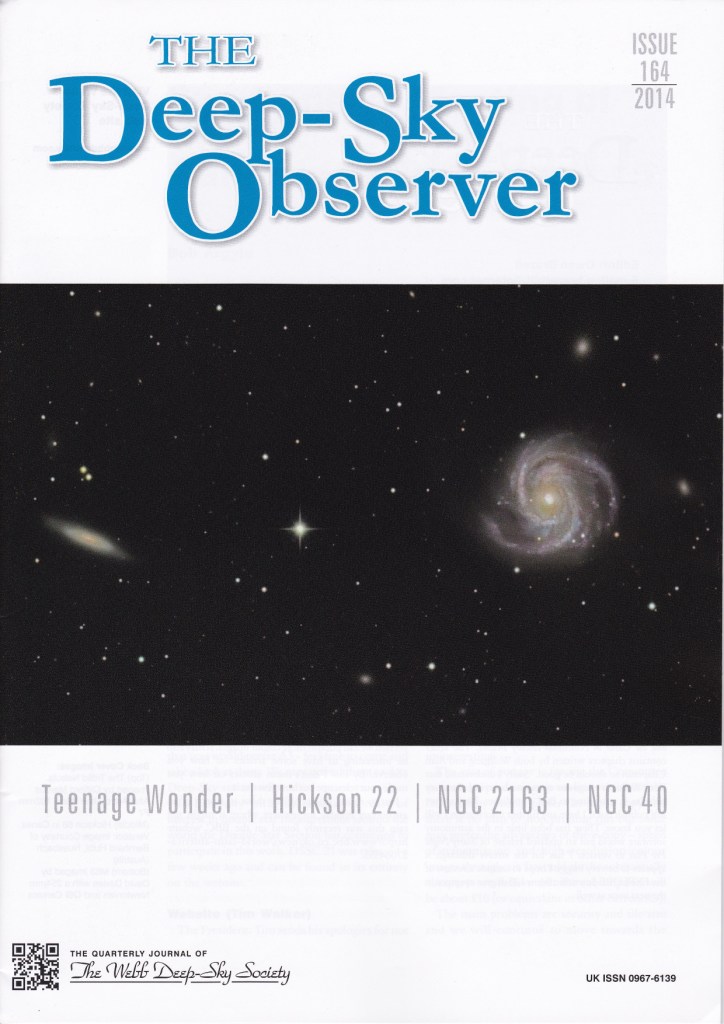
The Deep Sky Observer
The Webb Archive DVD holds scans of all the Magazine and Journal Publications released by the Webb Society since the first Quarterly Journal in 1968 and some 250 people have contributed articles over the 40+ year period.
In 2007, The Webb Society celebrated its 40th anniversary. It was formed as a result of interest shown in early deep-sky columns by John Larard in The Astronomer magazine. Since the first Quarterly Journal (Vol 1 No 1) came out in June 1968 the Society has been constantly active and the ‘QJ’ (later to evolve into the Deep-Sky Observer) has been the main organ through which observations have been transmitted to enthusiasts all around the world.
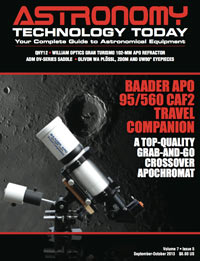
Astronomy Technology Today Magazine
We are the only magazine in the world dedicated entirely to telescopes and related equipment. We offer both print and digital versions and as a subscriber you can view every back issue online, which means that you’ll have access to over 400 reviews, how to articles, new product introductions, industry news, ATM articles, astrophotography, and much more.

Amateur Astronomy Magazine
Over the course of the past 21 years, we have covered telescopes, large and small, amateur telescope making (ATM), mirror grinding, collimating tips, observing techniques, astronomical equipment reviews, home observatories, professional observatories, observing lists, profiles of amateur astronomers, star parties, dark sites, imaging tips and techniques, observing logs, astronomical travel logs, astronomy businesses and their owners, DIY astronomical projects, cosmology, science and astronomy outreach. In short, we are about all the things and people that make this hobby special.